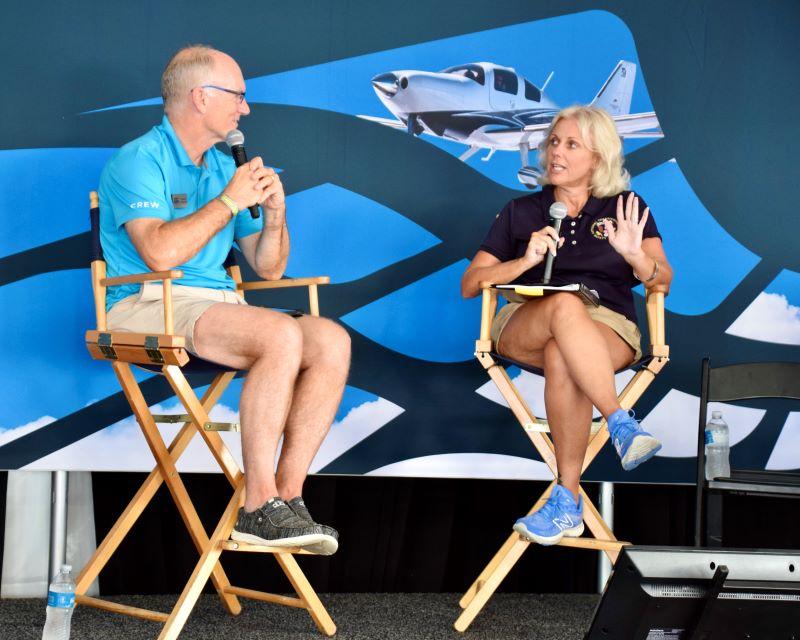
NTSB Chair Jennifer Homendy speaks with Richard McSpadden of the AOPA Air Safety Institute.
OSHKOSH—Learning to fly is expensive, attests NTSB Chair Jennifer Homendy, who is working toward a private pilot’s license.
“I’ve been really focused on trying to get kids and women in aviation—it’s expensive,” Homendy said, speaking July 25 at EAA AirVenture Oshkosh. “I pay $397 every time I take a flight lesson. That’s the plane, that’s the equipment and the instructor. At first someone said, ‘you should really fly a couple of times of week.’ I need to be rich because I’m on a federal salary and that’s not going to happen.”
An NTSB board member since 2018, Homendy was nominated by President Joe Biden and sworn in as its chairperson in August 2021, succeeding Robert Sumwalt. During a wide-ranging conversation with Richard McSpadden, Aircraft Owners and Pilots Association (AOPA) Air Safety Institute senior vice president, she described the aviation safety recommendations she feels most strongly about and the NTSB’s efforts to reduce the amount of time it takes to complete accident investigations.
Prompted by McSpadden, Homendy said she is committed to the safety board’s mission and is not desirous of being considered for the position of FAA administrator, now held by U.S. Transportation Department Deputy Secretary Polly Trottenberg in an acting capacity.
Homendy initially came to the NTSB with a background in rail and pipeline safety, among the modes the safety board investigates. She started training to fly in 2020 but was delayed early on by the COVID-19 pandemic. Her flight instructor is former NTSB senior air safety investigator Bill English, who is now chief pilot with Aviation Adventures at Leesburg Executive Airport, Virginia, outside of Washington.
“For ethics reasons, I cannot take lessons from current employees, but there are a lot of former employees,” Homendy related. “When I approached Bill [English] I said I really need to do it slow. It can be prohibitively expensive. I understand the charges, of course.”
McSpadden said the AOPA has lobbied for speedier and more standardized safety reporting by the NTSB and has seen the pace of its accident investigations, which typically take 18-24 months, accelerate in the past couple of years. Homendy attributed this to process improvements that Sumwalt and board member Bruce Landsberg, a former long-time AOPA executive, started and she continued. The board also worked to fill vacancies—there were 56 when Homendy became chairperson—and hired retirees to reduce its investigations backlog.
Regrettably, that caseload increased after Homendy spoke at EAA AirVenture. Four people were killed July 29 in two separate accidents involving aircraft attending the annual fly-in convention. One of the accidents, the midair collision of a Rotorway 162F kit helicopter and an ELA Eclipse 10 gyroplane, took place on-site at Wittman Regional Airport in Oshkosh.
Homendy said she feels strongly about recommendations the safety board has made for stricter FAA oversight of commercial passenger-carrying flights conducted under Part 91 general aviation rules. In March 2021, the NTSB made six recommendations after considering an aviation investigation report on Part 91 revenue passenger-carrying operations such as air tours, parachute jumps, aerobatic or historic aircraft experience flights and sightseeing balloon trips. Among those recommendations, it called on the FAA to require that operators implement safety management systems (SMS).
“I think if you’re a paying passenger, you should be guaranteed the same level of safety you would get in every passenger operation,” Homendy said. “I’m not saying the same regulation should apply from Part 121 [airlines] to Part 91. But you should be guaranteed the same level of safety—we’re talking about pilot training, maintenance, company policies, SMS. There are a lot of recommendations we issued as part of that report that I’m pretty passionate about.”





